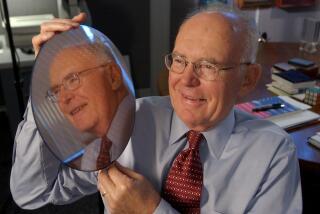Chip Inventor Says Motorola, Intel Won’t Contest Patent
- Share via
LAS VEGAS — Gilbert Hyatt, the lone La Palma inventor who emerged from obscurity in August with an apparently far-reaching patent on the microprocessor, said Wednesday that Intel and Motorola had decided not to contest that patent claim. As a result, Hyatt could be entitled to millions of dollars in license payments.
Hyatt, speaking at the Comdex computer trade show here in his first public appearance since announcing his patent for a “computer-on-a-chip,” also announced that he had been granted patents on another invention that could have a major impact on the personal computer business.
Intel and Motorola are the two major U.S. manufacturers of microprocessors, and they could be required to pay Hyatt tens of millions of dollars per year in patent licensing fees. Hyatt says he is negotiating licensing arrangements with companies that infringe on his patent, but he has declined to say how much he is asking for.
Intel has declined to comment on the Hyatt patent and would not say whether it had made a decision not to challenge it. Motorola officials could not be reached for comment.
Hyatt’s new invention is an enhancement for a widely used type of computer memory known as a dynamic random access memory, or DRAM. Hyatt says he has been able to increase the speed of DRAMs up to 300% by changing the way information is stored in and retrieved from the tiny DRAM chips, thus eliminating a major bottleneck in personal computer performance.
Currently, many PCs have to go into a “wait-state” while information is retrieved from the memory, and high-speed machines employ an adjunct memory called a cache to get around the speed problem. Hyatt said his invention could eliminate the need for wait-states and cache memories without any increase in cost and would work with any existing DRAM chips.
Hyatt said he was in negotiations with several personal computer companies that are interested in using the technology, but he declined to identify them. The efficacy of the technology could not be independently confirmed, however, and one chip specialist who attended the announcement contended that the 300% speed increase was an exaggeration.
“This will certainly pique the interest of every computer designer,” said Stan Baker, senior editor of the trade newspaper Electronic Engineering Times. Baker said memory speed was currently the most important issue in computer design but it was hard to tell from the documents what Hyatt had actually done.
Based on Hyatt’s announcement alone, “It’s still somewhat of a mystery exactly what he’s doing,” Baker said.
As in the case of his microprocessor patent, Hyatt’s memory design patent was also granted many years after the invention took place. He said his first memory design patent filing was made in 1970, but that most of the work dates from about 10 years ago. Hyatt filed for the microprocessor patent in December, 1970.
The new memory design patent, though, is likely to generate considerably less controversy than the microprocessor patent because the technology is not yet incorporated in any products. Many in the industry have been skeptical about Hyatt’s claim to have invented the microprocessor and say the situation simply points up the flaws in the patent system.
But Hyatt contends that the work done on the microprocessor at Intel and Texas Instruments was “derivative” of his own, and that those companies gained access to his technology via venture capitalists.
In his sparsely attended Comdex speech, Hyatt said that “a very receptive patent environment” has made the 1990s a great time for individual inventors. In portraying himself as David fighting the industry Goliaths, Hyatt said that big companies “stifle and suppress” individual inventors.
“Large companies don’t come up with significant inventions,” he asserted, and he encouraged lone inventors to forge ahead under the protection of better patent enforcement.






